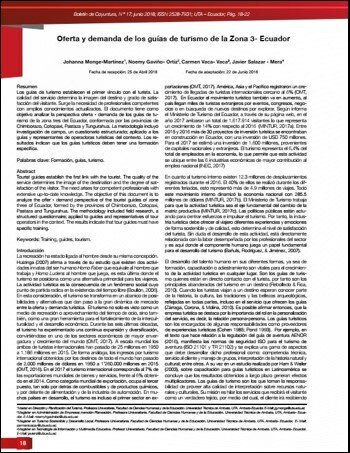Supply and demand of Tourism guides in Zone 3 - Ecuador
Main Article Content
Abstract
Tourist guides establish the first link with the tourist. The quality of the service determines the image of the destination and the degree of satisfaction of the visitor. The need arises for competent professionals with extensive up-to-date knowledge. The objective of this document is to analyze the offer - demand perspective of the tourist guides of zone three of Ecuador, formed by the provinces of Chimborazo, Cotopaxi, Pastaza and Tungurahua. The methodology included field research, a structured questionnaire; applied to guides and representatives of tour operators in the context. The results indicate that tour guides must have specific training.
DOI: https://doi.org/10.31164/bcoyu.17.2018.668
URL: http://revistas.uta.edu.ec/erevista/index.php/bcoyu/article/view/668
Downloads
Article Details

This work is licensed under a Creative Commons Attribution-NonCommercial 4.0 International License.
![]()
The publications of the Boletín de Coyuntura are licensed under a Creative Commons Attribution-NonCommercial 4.0 International License (CC BY-NC 4.0). The Universidad Técnica de Ambato retains the copyright of the published works, and favors and allows the reuse of these, as long as: the authorship and original source of publication is cited, and they are not used for commercial or onerous purposes. The intellectual property of the published articles belongs to the authors.
References
AENOR. (10 de 02 de 2016). aenor.es. Obtenido de http://www.aenor.es/aenor/normas/normas/fichanorma.asp?tipo=N&codigo=N0056174#.WSdAtWiGPIV
Bañuls, A. L., Rodríguez, A. B., & Jiménez, M. S. (2007). El capital humano como factor estratégico para la competitividad del sector turístico. Cuadernos de turismo, 19, 47-69.
Bote, V. (1995). Estructura y desarrollo del turismo en España: hacia un cambio cualitativo y más responsable. España: In Congreso de Economía del Turismo.
Boullón, R. (2006). El Sistema Turístico. México: TRILLAS.
Cohen, E. (1985). The tourist guide: The origins, structure and dynamics of a role. 1985 The tourist guide: The origins, structure and dynamics of a role. Annals of Tourism Research, 12(1), 5-29.
Ham, S. H., & Weiler, B. (2003). Capacitación para guías turísticos en Latinoamérica. Estudios y Perspectivas en Turismo, 12, 24-47.
Huizinga, J. (2007). Homo Ludens. Madrid: Alianza
INEC. (2017). Encuesta Nacional de empleo, desempleo y subempleo. Indicadores laborales. Quito: INEC.
ISO. (2007). Norma ISO para guías de turismo. Quito, Pichincha.
López, M. (2013). Aprendizaje, competencias y TIC. México: PEARSON.
MINTUR. (2017d). Listado de los Principales Destinos del Ecuador para Turismo Receptivo. 2017. Quito: MINTUR- Dirección de productos y destinos 2017.
MINTUR. (26 de abril de 2017b). Ministerio de Turismo. Obtenido de Entradas y Salidas Internacionales por Nacionalidad: http://servicios.turismo.gob.ec
MINTUR. (03 de diciembre de 2017a). Ministerio de Turismo. Obtenido de Noticias: https://www.turismo.gob.ec/arribo-de-turistas-a-ecuador-crecio-en-14-en-2017/
MINTUR. (05 de junio de 2017c). Ministerio de Turismo. Obtenido de Noticias: https://www.turismo.gob.ec/el-turismo-sera-el-eje-del-cambio-de-la-matriz-productiva-en-ecuador/
OMT. (2016). Panorama OMT del Turismo Internacional. Edición 2016. UNWTO.
OMT. (2017). Panorama OMT del Turismo internacional. Edición 2017. UNWTO.
OMT; UNESCO. (2015). La Conferencia Mundial sobre Turismo y Cultura. Camboya: OMT, UNESCO.
Pond, K. (1993). The professional guide: dynamics of tour guiding. New York: Van Nostrand Reinhold.
Prado, V. S. (2001). Oportunidades de capacitación de recursos humanos en turismo. Santiago: Servicio Nacional de Turismo.
Ramallo, E. (2015). EL GUÍA TURÍSTICO DIFERENCIAS Y SIMILITUDES ENTRE COMUNIDADES AUTÓNOMAS. Cuadernos de Turiso (35), 499-510.
Rebolledo Dujisin, P., & Fica Pérez, R. (2010). La formación de guías de turismo de montaña y alta montaña: el caso chileno. Gest. tur. (Valdivia), 14, 83-95.
Reglamento de Guianza Turística. (2016). Quito: Lexis.
Reglamento General de Actividades Turísticas. (2011). Quito: Lexis.
Swarbrooke, J. (1999). Sustainable Tourism Management. UK: CABI Publishing.
Yu, X., Weiler, B., & Ham, S. (2001). Intercultural communication and mediation: A framework for analysing the intercultural competence of Chinese tour guides. Journal of Vacation Marketing, 2 - 3.
Zárraga, L., Corona, E., & Molina, V. (2010). Las competencias de los guías de turistas como ventaja competitiva en el sector turista: Caso Cancún Quintana Roo. REVISTA INTERNACIONAL ADMINISTRACION & FINANZAS, 3(3), 11-24.


